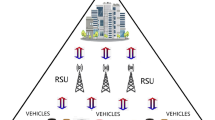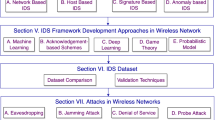Abstract
A wireless multihop network is emerging as one of the most important technologies in the field of ubiquitous networking. However, a number of formidable challenges remain, several of the most crucial been associated with robustness and network security. In this paper, we introduce a comprehensive resilient security framework for wireless ad hoc networks that are using multipath routing. It deploys an integrated multisignatures scheme and uses a self-certified public keying technique to ensure secure route discovery. In addition, it uses the Schnorr signature scheme along with an information dispersal algorithm to ensure secure data transfer. We provide security analysis of the proposed approach and compare it with several existing popular schemes. It can be seen that the proposed approach is more secure than other existing schemes. We also evaluated the proposed approach by means of computer simulation and compared its performance to that of the existing popular schemes. The results are in favor of the proposed technique in terms of efficiency and effectiveness.
Similar content being viewed by others
References
Mueller S., Tsang R. P., Ghosal D. (2004) Multipath routing in mobile ad hoc networks: Issues and challenges. Performance Tools and Applications to Networked Systems, Springer LNCS 2965: 209–234
Johnson, D., Hu, Y., & Maltz, D. (2007). The dynamic source routing protocol (DSR) for mobile ad hoc networks for IPv4. IETF RFC 4728. IETF.
Lee, S. J., & Gerla, M. (2001). Split multipath routing with maximally disjoint paths in ad hoc networks. In Proceedings of IEEE ICC’01, Helsinki, Finland (Vol. 3, pp. 867–871). IEEE.
Wang, L., Zhang, L., Shu, Y., & Dong, M. (2000). Multipath source routing in wireless ad hoc networks. In Proceedings of Canadian Conference on Electrical and Computer Engineering (CCECE 2000) (Vol. 1, pp. 479–483). IEEE.
Anjum F., Mouchtaris P. (2007) Security for wireless ad hoc networks. Wiley, New York
Hu, Y. C., Perrig, A., & Johnson, D. B. (2002). ARIADNE: A secure on-demand routing protocol for ad hoc networks. In Proceedings of MobiCom 2002, Atlanta, Georgia, USA. ACM.
Acs G., Buttyan L., Vajda I. (2006) Provably secure on-demand source routing in mobile ad hoc networks. IEEE Transactions on Mobile Computing 5(11): 1533–1546
Papadimitratos, P., & Haas, Z. J. (2002, January). Secure routing for mobile ad hoc networks. In Proceedings of SCS Communication Networks and Distributed Systems Modeling and Simulation Conference (CNDS 2002), San Antonio, TX, USA. SCS.
Mavropodi R., Kotzanikolaoua P., Douligerisa C. (2007) SecMR: A secure multipath routing protocol for ad hoc networks. Elsevier Ad Hoc Networks 5(1): 87–99
Marshall, J., Thakur, V., & Yasinsac, A. (2003). Identifying flaws in the secure routing protocol. In Proceedings of the 22nd International Performance, Computing, and Communications Conference (pp. 167–174). IEEE.
Papadimitratos P., Hass Z. (2002) Securing mobile ad hoc networks. In: Ilyas M. (eds) The handbook of ad hoc wireless networks. CRC Press, Boca Raton
Papadimitratos P., Haas Z. (2006) Secure data communication in mobile ad hoc networks. IEEE Journal on Selected Areas in Communications 24(2): 343–356
Lou W., Liu W., Zhang Y., Fang Y. (2009) SPREAD: Improving network security by multipath routing in mobile ad hoc networks. Springer Wireless Networks 15(3): 279–294
Kim, J., & Tsudik, G. (2005). SRDP: securing route discovery in DSR. In Proceedings of Second Annual International Conference on Mobile and Ubiquitous Systems: Networking and Services (MobiQuitous 2005) (pp. 247–258). IEEE Computer Society.
Micali, S., Ohta, K., & Reyzin, L. (2001). Accountable–subgroup multisignatures. In Proceedings of the 8th ACM conference on Computer and Communications Security, Philadelphia, PA, USA (pp. 245–254). ACM.
Girault, M. (1991). Self-certified public keys. In Proceedings of Advances in Cryptology: Eurocrypt’91 (pp. 490–497). Berlin: Springer.
Lee, B., & Kim, K. (2000). Self-certificate: PKI using self-certified key. In Proceedings of CISC 2000 (Vol. 10(1), pp. 65–73). KIISC.
Rabin M. O. (1989) Efficient dispersal of information for security, load balancing, and fault tolerance. Journal of the ACM 36(2): 335–348
OPNET Modeler Simulation Software. (2009). Accessed on August, from http://www.opnet.com.
Author information
Authors and Affiliations
Corresponding author
Rights and permissions
About this article
Cite this article
Vaidya, B., Makrakis, D., Park, J.H. et al. Resilient Security Mechanism for Wireless Ad hoc Network. Wireless Pers Commun 56, 385–401 (2011). https://doi.org/10.1007/s11277-010-9978-7
Published:
Issue Date:
DOI: https://doi.org/10.1007/s11277-010-9978-7




